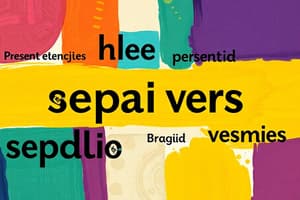Podcast
Questions and Answers
Yo ______ soy un estudiante.
Yo ______ soy un estudiante.
soy
Nosotros ______ hablamos español.
Nosotros ______ hablamos español.
hablamos
Él ______ es un médico.
Él ______ es un médico.
es
Tú ______ estás en la escuela.
Tú ______ estás en la escuela.
Yo me ______ a mi amigo.
Yo me ______ a mi amigo.
De eerste persoon enkelvoud van het werkwoord 'comprar' (kopen) is _____.
De eerste persoon enkelvoud van het werkwoord 'comprar' (kopen) is _____.
Het werkwoord 'hablar' (spreken) volgt het typische patroon voor de derde persoon enkelvoud ('él habla, ella habla'), maar heeft een onregelmatige vervoeging voor de eerste persoon enkelvoud ('yo ____').
Het werkwoord 'hablar' (spreken) volgt het typische patroon voor de derde persoon enkelvoud ('él habla, ella habla'), maar heeft een onregelmatige vervoeging voor de eerste persoon enkelvoud ('yo ____').
De derde persoon enkelvoud van het werkwoord 'volar' (vliegen) is _____.
De derde persoon enkelvoud van het werkwoord 'volar' (vliegen) is _____.
Regelmatige werkwoorden eindigen meestal op '-ar', '-er' of '-ir'. Om de tegenwoordige tijd te vormen, verwijder je de laatste letter van de stam en voeg je de juiste uitgang toe op basis van de persoon of het voornaamwoord. Bijvoorbeeld: Verb: Comprar (kopen). Derde persoon enkelvoud: Él/ella/ello _____.
Regelmatige werkwoorden eindigen meestal op '-ar', '-er' of '-ir'. Om de tegenwoordige tijd te vormen, verwijder je de laatste letter van de stam en voeg je de juiste uitgang toe op basis van de persoon of het voornaamwoord. Bijvoorbeeld: Verb: Comprar (kopen). Derde persoon enkelvoud: Él/ella/ello _____.
Onregelmatige werkwoorden volgen niet het reguliere patroon van het toevoegen van een uitgang op basis van de persoon of het voornaamwoord dat wordt gebruikt. Ze hebben unieke vervoegingen in de tegenwoordige tijd. Deze werkwoorden worden ook wel _____.
Onregelmatige werkwoorden volgen niet het reguliere patroon van het toevoegen van een uitgang op basis van de persoon of het voornaamwoord dat wordt gebruikt. Ze hebben unieke vervoegingen in de tegenwoordige tijd. Deze werkwoorden worden ook wel _____.
Flashcards are hidden until you start studying
Study Notes
Spanish A1 Verbs
Present Tense
The present tense in Spanish is formed using the stem of the verb and adding the appropriate ending based on the person or pronoun used. Regular verbs, those that end in "-ar," "-er," or "-ir," follow this pattern, while irregular verbs may have unique conjugations.
For example, the verb "hablar" (to speak) follows the typical pattern for third-person singular ("él habla, ella habla") but has an irregular conjugation for the first person singular ("yo hablo").
To navigate the complexities of Spanish verb conjugations, it can be helpful to consult resources like the Spanish Verbs For Dummies cheat sheet and online courses that cover Spanish grammar for beginners.
Regular Verbs
Regular verbs act similarly to English verbs in terms of conjugation. They typically end in "-ar," "-er," or "-ir." To form the present tense, you remove the final letter of the base form and add the appropriate ending based on the person or pronoun.
Here are a few examples:
- Verb: Comprar (to buy). First person singular: Yo compro, Second person singular: Tú compras, Third person singular: Él/ella/ello compra.
- Verb: Volar (to fly). First person singular: Yo vuelo, Second person singular: Tú vuela, Third person singular: Él/ella/ello vuela.
Remember that there are exceptions for irregular verbs when using the present tense.
Irregular Verbs
Irregular verbs do not follow the regular pattern of adding an ending based on the person or pronoun used. Instead, they have unique conjugations for each person and number. Some examples of common irregular Spanish verbs include:
- Ser (to be): Yo soy, Tú eres, Él/ella es, Nosotros/ellos somos.
- Estar (to be): Yo estoy, Tú estás, Él/ella está, Nosotros/ellos estamos.
- Hablar (to speak): Yo hablo, Tú hablas, Él/ella habla, Nosotros/ellos hablamos.
For a comprehensive list of irregular verbs and their corresponding present tense forms, you can refer to resources like the Spanish Verbs For Dummies cheat sheet.
Common Verbs
Common verbs are essential words in any language, including Spanish. Some common Spanish verbs that require a preposition "a" before a noun or infinitive include:
- Acercarse a: To approach
- Acostumbrarse a: To get used to
- Aficionarse a: To become fond of
- Asistir a: To attend
- Ayudar a: To help
- Dar a: To face
- Decidirse a: To decide to
These verbs play a crucial role in expressing various actions and concepts in Spanish conversations and written communication.
Studying That Suits You
Use AI to generate personalized quizzes and flashcards to suit your learning preferences.




